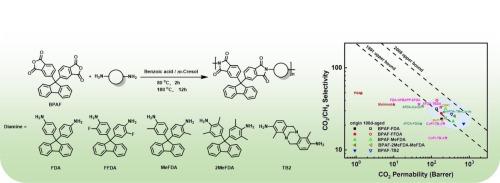9,9-双(3,4-二羧基苯基)芴二酐本征微孔聚酰亚胺的合成及气体分离性能
IF 6.3
2区 化学
Q1 POLYMER SCIENCE
引用次数: 0
摘要
以9,9-二(3,4-二羰基苯基)芴二酐(BPAF)与含芴二胺或Tröger碱二胺聚合,合成了5种本征微孔聚酰亚胺(PIM-PI)。对其微观结构、热、力学和气体输运性能进行了详细的表征。这些pim - pi的玻璃化转变温度为416-466℃,模量为1.8-3.2 GPa。这些聚合物的BET比表面积、分数自由体积和平均链间距离分别为362 ~ 497 m2 g−1、0.204 ~ 0.237和6.01 ~ 6.18 Å。因此,基于bpaf的pim - pi具有较高的透气性和适度的选择性。特别是,BPAF-TB2和BPAF-2MeFDA-MeFDA接近2008年Robeson的CO2/CH4分离上限。此外,这些pim - pi具有优异的抗塑化和耐老化性能,并且在老化100天后其气体分离性能甚至有所提高。本文章由计算机程序翻译,如有差异,请以英文原文为准。

Synthesis and gas separation performance of intrinsically microporous polyimides derived from 9,9-bis(3,4-dicarboxyphenyl)fluorene dianhydride
Five polyimides of intrinsic microporosity (PIM-PI) were synthesized by the polymerization of 9,9-bis(3,4-dicarboxyphenyl)fluorene dianhydride (BPAF) with fluorene-containing diamines or Tröger’s Base diamine. Their microstructures, and thermal, mechanical and gas transport properties were characterized in detail. These PIM-PIs exhibited glass transition temperatures of 416–466 °C and modulus of 1.8–3.2 GPa. The BET surface areas, fractional free volume, and average interchain distances of these polymers were 362–497 m2 g−1, 0.204–0.237, and 6.01–6.18 Å, respectively. Thus, the BPAF-based PIM-PIs showed high gas permeability and modest selectivity. Particularly, BPAF-TB2 and BPAF-2MeFDA-MeFDA approached the 2008 Robeson’s upper bound for CO2/CH4 separation. Further, these PIM-PIs exhibited excellent resistance to plasticization and ageing, and their gas separation performance was even improved after 100 days of ageing.
求助全文
通过发布文献求助,成功后即可免费获取论文全文。
去求助
来源期刊

European Polymer Journal
化学-高分子科学
CiteScore
9.90
自引率
10.00%
发文量
691
审稿时长
23 days
期刊介绍:
European Polymer Journal is dedicated to publishing work on fundamental and applied polymer chemistry and macromolecular materials. The journal covers all aspects of polymer synthesis, including polymerization mechanisms and chemical functional transformations, with a focus on novel polymers and the relationships between molecular structure and polymer properties. In addition, we welcome submissions on bio-based or renewable polymers, stimuli-responsive systems and polymer bio-hybrids. European Polymer Journal also publishes research on the biomedical application of polymers, including drug delivery and regenerative medicine. The main scope is covered but not limited to the following core research areas:
Polymer synthesis and functionalization
• Novel synthetic routes for polymerization, functional modification, controlled/living polymerization and precision polymers.
Stimuli-responsive polymers
• Including shape memory and self-healing polymers.
Supramolecular polymers and self-assembly
• Molecular recognition and higher order polymer structures.
Renewable and sustainable polymers
• Bio-based, biodegradable and anti-microbial polymers and polymeric bio-nanocomposites.
Polymers at interfaces and surfaces
• Chemistry and engineering of surfaces with biological relevance, including patterning, antifouling polymers and polymers for membrane applications.
Biomedical applications and nanomedicine
• Polymers for regenerative medicine, drug delivery molecular release and gene therapy
The scope of European Polymer Journal no longer includes Polymer Physics.
 求助内容:
求助内容: 应助结果提醒方式:
应助结果提醒方式:


